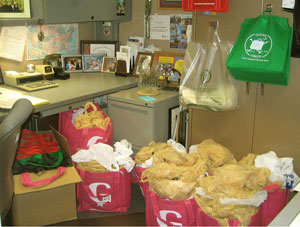Plastic bags are lightweight, durable, waterproof, reusable, take up little storage space, and are convenient because they have handles and are easy to carry. That is why they are preferred by most customers. They are also cheap, typically costing about 1-2 cents to produce, compared to 10 cents for a paper bag. As a result, they are everywhere – literally. Like flimsy kites, they fly around and get tangled in trees. They litter beaches and have been found floating in the ocean in the Arctic Circle. They clog drains, causing flooding. They can choke and kill whales, dolphins, birds, sea turtles and other animals, including pets. Depending on conditions, they can last for hundreds, if not thousands, of years.
Plastic bag use has increased 320% from 1980-2001. More than 380 billion plastic bags are used each year in the U.S. alone. Although most are recyclable, nationwide less than 5.4% are actually recovered. (Source: EPA, 2001) Plastic bags put in recycling bins often end up in landfills or incinerators. That is because cities like San Francisco found it can cost $4000 to process and recycle one ton of plastic bags, while the commodities market pays only $32 a ton. The newer “compostable” bags degrade only in industrial scale composting plants, not in a compost bin, and cannot be recycled with ordinary plastic bags.
In response, whole countries have started banning free plastic bags. It began in Bangladesh in 2002. The Chinese, who use up to 3 billion plastic shopping bags a day, could save 37 million barrels of oil each year as a result of their ban. (Source: Scientific American.) In March 2007, San Francisco became the first U.S. city to ban plastic bags. The first town in Connecticut – Westport – jumped on board in September 2008. Other countries and individual stores like IKEA have instituted taxes, additional charges for plastic bags, and/or rebates for using cloth totes.
The word about the plastic plague is spreading. On June 11, Delia Fey, Town Planner for Woodstock CT, emailed me a PowerPoint slideshow called The Dangers of Plastic Bags. You can download it HERE or watch it on YouTube. It is factual, visual and compelling. Vishal Mody, a high school science teacher in Chicago, created this short video. I forwarded it to some of my environmental colleagues. A few months later, I amazed to hear about the chain reaction it caused almost 3,000 miles away.
 |
Bag the Plastic Bags! This is what Janet Wendland’s cubicle looked like last week after co-workers traded the plastic bags for reusable canvas bags she provided in an effort to reduce environmental pollution. Photo, caption and quotes courtesy of Energy Northwest. |
It was shown to a number of staff at Energy Northwest, an environmentally-conscious power plant in Richland, Washington. Afterwards, many viewers were motivated to change their shopping habits to reduce their use of plastic bags. One employee – Janet Wendland – took it a step further. “After watching the video about the dangers of plastic bags,” says Janet, “I forwarded it to the 47 people in my group…. Anyone in the group who brought in 12 or more plastic bags would receive a reusable fabric bag in their color choice of red, green or black (mine are pink). I collected only 410 bags and am amazed at how much space just that many take up. The video talks in numbers of millions and millions – it just boggles the mind when looking at the measly little 410 that I am recycling! I have to get them out of my office as they are starting to call me the ‘Bag Lady.’ “
Delia Fey also starting using cloth bags more after watching the video. “It does require some planning ahead. I have to remind myself to keep putting the cloth totes back in the car when I get back from shopping,” says Fey. The most popular totes are flat bottomed, stiff, inexpensive, lightweight, and washable. A darker color won’t show dirt. Personally, I like the ones that have comfortable handles that are also long enough to fit over the shoulder. Paper bags are another option if they are recycled after use. “On those occasions when you do use plastic, try to reuse them or at least don’t let them blow off into the wind – the wild creatures among us depend on our not setting booby-traps to trap them when they think they are eating dinner, “ says Fey. Don't accept a bag for one small item. “It’s such a simple thing we can all do to help our environment,” says Wendland.
|

